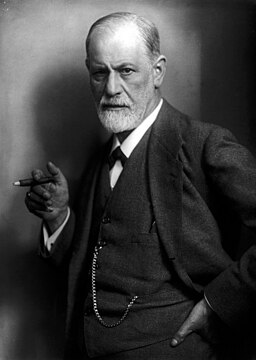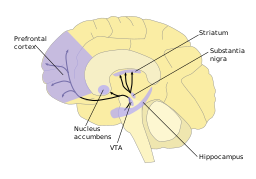
Freud, Cocaine and the Dopamine Hypothesis of Addiction

It seems to me noteworthy – and I discovered this in myself and in other observers who were capable of judging such things – that a first dose or even repeated doses of coca produce no compulsive desire to use the stimulant further; on the contrary, one feels a certain unmotivated aversion to the substance.
– Sigmund Freud, Über Coca
Till the end of his days, Freud remained convinced about the beneficial nature of cocaine, and strongly advocated its use for medicinal purposes. In an idea that was surprisingly ahead of his time, though ultimately misguided, he even suggested that cocaine be used as a substitution therapy for de-addicting patients from morphine or alcohol.
Freud isn’t alone among illustrious personalities in having dabbled with cocaine, heroin, morphine or any of the other well-known drugs of abuse. Recreational drug use has always been common, particularly among certain social, occupational or age groups, drug prohibition laws notwithstanding. And a really curious fact that is rarely talked about in scientific literature is that many of these users somehow escape without any negative consequences, and never develop the compulsive addiction that makes these drugs so deadly to the population at large.
Addiction involves a feeling of compulsion, of just-having-to-do-it, and a helpless dependence on the addict’s drug of choice. A hallmark feature of addiction is persistence in spite of negative outcomes – continuing to take the drug even when it is clearly harming one’s health and lifestyle. This compulsion rapidly deteriorates into a state of overbearing apathy, where everything in the world apart from the drug ceases to hold meaning. In the 1950s and 60s, researchers showed that addiction can be effectively modelled in rodents using a self-stimulation paradigm, where rats or mice simply pressed a lever and received either an injection of a drug, or a stimulating current in one of the brain regions believed to be associated with the feeling of pleasure. The animals learned quickly, and would sometimes press the lever for hours on end, slowly progressing to dependence.

Scientists have seen that dopamine levels in the NAc rise sharply soon after sex, as well as after a tasty meal. Drugs of abuse, including cocaine, heroin and morphine also increase dopamine in the brain, to levels several times higher than what is seen for food or sex. So much so, that after a while the circuit begins to desensitize, which means that the same amount of drug produces a lesser amount of pleasure each time, leading the abuser to continuously increase dosage. This might also explain the increasing apathy towards sex or food or any such ‘naturally’ rewarding stimuli in chronic drug abusers.
Even though the dopamine hypothesis of addiction has been around a long time, conclusive evidence in its support has been lacking. Multiple other molecules, like opioid receptors and other monoamine neurotransmitters have also been implicated in mediating the effects of addiction on the brain. A recent study, from researchers at the University of Geneva, Switzerland, attempted to test once and for all whether or not dopamine is sufficient for the progression to addiction.

In their experiment, mice were hooked up to a self-stimulation apparatus, like the one shown on the right. These mice had previously been injected with a virus, which made the dopamine-producing neurons in the VTA sensitive to light of a particular wavelength – i.e. whenever Laser light is shone on these cells, they get activated (a technique known as optogenetics). Whenever the mouse pressed a lever, it turned on a laser which shone light on the VTA via a thin fiber-optic cable implanted in the mouse’s brain. If lever press is not linked to any reward, mice quickly get bored, and move on to other and better things. In this case however, it was very apparent that the mice were enjoying the self-stimulation, as in no time they were observed pressing the lever up to 400 times in under an hour, and turning on the laser with an alarming frequency.
Another feature of this experiment was a ‘cue’, a signal that was provided to the mice every time they pressed the lever and the laser was about to be turned on. The cue was a small light that was turned on just before the laser activation took place. In case of addicts, it is well known that such cues often get associated with the experience of pleasure after drug intake, and on encountering such a cue again, those in withdrawal often suffer a relapse. To model this, mice were brought back to the stimulation chamber 30 days after the last stimulation trial – a long time in the life of a rodent. But as soon as the light was turned on, a mad frenzy of lever pressing ensued – even when no laser stimulation accompanied the lever presses – the mice continued to press the lever in anticipation of a reward that never materialized.
As I mentioned before, the trademark behavior of an addict is compulsive drug seeking even in the face of negative consequences. To introduce an element of this in this mouse model, the researchers decided to pair a little foot shock to the lever-press paradigm – whenever the poor mouse pressed a lever, it received the laser burst stimulation as before, but about a third of the laser bursts were accompanied by a mild, but sharp, electric shock to the foot. And here, the mice started displaying a really interesting behavior. Some mice started reducing the number of laser stimulations when it became clear that receiving a shock was a likely result, and had decreased lever presses by more than 80% before the hour was up. A small group, however, continued pressing the lever and receiving the stimulation in spite of receiving shocks, showing surprisingly little sensitivity to the pain. The scientists called the first group of animals ‘sensitive’, and the second group ‘resistant’.
It was clear that the resistant group appeared to have crossed the threshold to addiction – they persisted in self-stimulating even when doing so led to pain and punishment. A similar population divergence was seen when mice were trained to self-stimulate with cocaine. If the reward was sucrose, on the other hand, all the animals reduced their lever presses reliably upon receiving electric shocks. Sugar, it appears, is simply not worth it.
This begs the question of what distinguishes the resistant mice from the sensitive ones. One hypothesis could be that the resistant mice were simply thick-skinned – they did not feel as much pain as the sensitive ones on being shocked – but the scientists soon proved this hypothesis wrong (by dipping their tails in hot water, and noticing that both groups were equally prompt in removing them from harm’s way). During training, both groups had stimulated themselves in the exact same manner, for the same duration, with the same frequency. They learned self-stimulation equally well, and were virtually indistinguishable from each other in all behavioral measures. Except one.
During the self-stimulation paradigm, there is short time lag between the time the animal presses a lever, and when it receives the laser-burst stimulation in its brain. Further lever presses during this time does nothing to the amount or nature of laser burst received. One curious behavior that the mice displayed during the test was a tendency to continue pressing the lever in the few seconds between the cue and the laser stimulation, as though impatient and unable to wait for the reward (If you have ever stood near an elevator, pressing the up/down button multiple times and swearing that the thing is stuck, you might be able to sympathize with the mouse here). When the scientists checked their data, they found that the mice who executed more of these ‘futile’ presses during training, were the animals who turned out to be ‘resistant’, or addicted during the punishment trials.
In talking about brain circuits involved in pleasure, reward and addiction, it is the VTA-NAc circuit that is mentioned most often. However, there are multiple other brain regions that influence reward-related behavior by directly or indirectly talking to this circuit. The orbitofrontal cortex (OFC) is one such region (yes, neuroscientists have an unfortunate penchant for long names), which is located towards the front of the brain, and is involved in many higher order functions such as decision making and reinforcement learning. Upon looking into the brains of the resistant and sensitive mice, the scientists found that there was much higher activation of the orbitofrontal cortex in the resistant animals when compared to the sensitive ones. So the scientists performed the logical next experiment, and inhibited the orbitofrontal cortex at the time of the punishment trials. Fascinatingly, only a small number of animals proved resistant to punishment with their OFC inhibited, the majority now shifting towards being sensitive.
What does this mean for addiction-therapy for humans and can drugs acting on the orbitofrontal cortex be used target addictive behaviors in the future? Time alone will show. Until then we can thank the little laser-obsessed mice for their important contribution towards us understanding a little bit more about our brains.
Reference –
Pascoli V, Terrier J, Hiver A, Lüscher C. Sufficiency of Mesolimbic Dopamine Neuron Stimulation for the Progression to Addiction. Neuron 2015;:1–13.
i16y42
1r4yop
987kp6
0yh12w